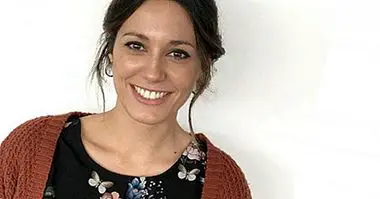Understanding the importance of attachment: interview with Cristina Cortés
Attachment is one of the most important aspects of human psychology . The emotional component of the emotional bonds that we establish have a great influence on our way of living and developing, both in our adult life and in our childhood. In fact, research suggests that the forms of attachment we experience during our first years of life leave an important imprint on us.
Therefore, understanding how attachment is related to parenting is very important.
- Related article: "The Theory of Attachment and the bond between parents and children"
Understanding the attachment: interview with Cristina Cortés
On this occasion we interview Cristina Cortés, a psychologist specialized in childhood and youth therapy at the Vitaliza psychology center in Pamplona.
Attachment is often confused with other terms such as love, but what is attachment really?
We can consider the attachment theory developed by John Bowlby as an attempt to conceptualize and explain the tendency and need of human beings to become attached, that is, to create affective bonds and at the same time, an attempt to explain the emotional pain that occurs as a consequence of the separation and loss of these relationships.
According to the theory of attachment, babies tend to create an emotional bond with their parents, a link that will be associated with their self-confidence as they grow up. An inadequate establishment of this link in childhood can lead to later psychological difficulties.
We are imminently social beings, we need the contact of the other, of another brain to adequately develop ours. Attachment is mediated by biology, we are genetically prepared to attach ourselves to our mother as soon as we are born. It will be the quality and quantity of these affective interactions that will develop the attachment and the bond.
There are several researchers who have contributed valuable knowledge about attachment, some as well known as John Bowlby. Although his theory has been interpreted by multiple authors, he was one of the first theorists to focus attention on the affective bond with our parental figures at an early age. When does attachment begin to develop?
We can say that the first social bonds are formed during pregnancy and birth, which is when we have the most urgent need to depend on others. Social ties are going to be strengthened during breastfeeding and parental interactions from a very early start.
Oxytocin, the hormone of love, or the timid hormone, as it is known, mediates the biological processes that favor attachment behaviors. Hormone Shy because it only occurs in safety contexts. Therefore we can say that security is the preamble of attachment. All this implies that we are talking about biological processes and not romantic love.
A few months ago you participated in the "I Day of attachment" held in Pamplona. During your talk you talked about the different types of attachment. Could you explain them briefly?
Yes, in short, we can say that the function of attachment is to guarantee the safety of the baby and the child. This implies that when the baby, the child, experiences discomfort it is attended to and calmed down. It is what any baby expects, that their attachment figures attend to their needs. As this happens, the baby first and then the child develops the neural circuits that lead him to regulate his state of mind, that is, the child learns to calm down by being calm.
The secure attachment will be that in which the child is certain that whatever happens will be calm, calm. He is fortunate to grow up and develop a confident image of himself and that he can trust others. Parents are good and sensitive enough to see the needs of the child, not just the physical ones.
Insecure attachment is that, in which the child does not experience his caregivers as a secure base. This may be due to attachment figures having difficulty connecting with emotions, not attending to them and focusing on the action, avoiding contact and emotional content in the interaction: model is known as avoidant attachment. Or that the caregivers are not sufficiently consistent in their care and regulation of affection. In this case, the child grows up with the uncertainty of whether his parents will be there for him or not, sometimes they are there and sometimes not. This type is called ambivalent or worried attachment.
And at the other end of security is the disorganized attachment that occurs when the baby or child has negligent or frightening caregivers who do not cover the physical and emotional needs and when caregivers are at the same time the source of terror. These caregivers do not calm the child and thus it will hardly reach a healthy emotional regulation.
In the book Look at me, feel me: strategies for the repair of attachment in children through EMDR, edited by Desclèe de Brouwer, I take a tour of the different models of attachment. The safe attachment was presented through Eneko, the protagonist child that accompanies us throughout all the chapters. From its conception until the age of 7, Eneko's parents become a model of secure attachment for readers.
Why is attachment important to developing healthy self-esteem?
Children who have a secure attachment model have sensitive parents who can read their minds and attend to their needs. Such parents do not blame their children for the connection breaks that occur on a daily basis. They are always ready to repair the ruptures, to propitiate the reconnection. And when they introduce the no, the attention calls and the limits, they do not focus on the behavior and do not devalue the child.
Self-esteem is the affection we feel towards ourselves and is the result of the image we have created of ourselves. This image is a reflection of the messages and affection that caregivers have given us when we do not know how to do and we are inexperienced and insecure.
- Maybe you're interested: "Child attachment: definition, functions and types"
Much is said about the link between attachment and well-being, but what is its relation to trauma?
Attachment and regulation go hand in hand. Our caregivers, as they calm and calm us down, help us regulate ourselves, so that the neural systems associated with regulation are formed and those circuits and that super capacity are created, as I like to call it. This super power is very important when things go wrong.
And the trauma is precisely that, "something has gone wrong, very badly". If we talk about attachment trauma, the trauma has occurred in the relationship with the caregivers and the regulation has been blown up, we do not have it. And if we talk about an external trauma, in a catastrophe for example, our response, our capacity for recovery will depend on my ability to regulate fear, emotions, the ability to trust, to hope that things can go well again. And curiously, the families that repair and repair their leg problems, transmit that faith that things have a solution.
A secure attachment is not about being a super father or mother. Perfect parents do not allow their children to grow up. The most desirable characteristic of secure attachment is knowing and being able to repair, not feeling attacked in that unequal power relationship between parents and children.
How can the fact of not having maintained a positive attachment style during childhood be problematic in adulthood?
According to Mary Main, the most important evolutionary function of attachment is the creation of a mental system capable of generating mental representations, especially representations of relationships. Mental representations that include affective, cognitive components and play an active role in guiding behavior. How I look to myself, and what I expect from others.
These mental representations that we create in childhood, in interaction with attachment figures, we project them into future personal and professional relationships and guide our interaction with others
It seems that EMDR therapy and Neurofeedback work very well in these cases. Why?
In Vitaliza we have been combining both therapies for more than 14 years, especially when they have had very early traumatic experiences, whether attachment or not, or when our system has been blown up due to the overload of chronic stress maintained at the same time. a long time. The two interventions promote improvement in many aspects.
The neurofeddback will help us improve our capacity for emotional regulation, and this greater regulation allows us to be able to process the trauma. Having a greater regulatory capacity facilitates and shortens the duration of the stabilization phase required to process the trauma, and allows us to process through EMDR the traumatic situations that are activated with triggers of the present.
What advice would you give to parents and mothers concerned about the style of raising their children? How can they be more likely to maintain the optimal balance between protection and freedom?
Most parents want to promote the best possible relationship with their children, and if they do not do it better it is usually because they lack knowledge and time. The lack of time and stress that families are currently experiencing is incompatible with a secure attachment, where time stands still and the center of attention is not only the baby but also the child. Babies, boys and girls need and require full attention, not divided by mobile or smartphone.
We need to face our children face to face, feel them, play with them, encourage interactions, play, laugh, tell them stories, free them from extracurriculars and spend time, as much as we can with them. Do not spend more time with multiple screens than with us, there is no computer that sits and smiled at you.



















